Yoga practices enhance mindfulness, flexibility, and mental strength, addressing common challenges in today’s fast-paced world. Techniques like breath control and meditation promote present-moment awareness and emotional regulation. Various styles, such as Kundalini and Yin yoga, offer unique benefits for practitioners. Regular engagement fosters resilience and adaptability, leading to improved overall well-being.
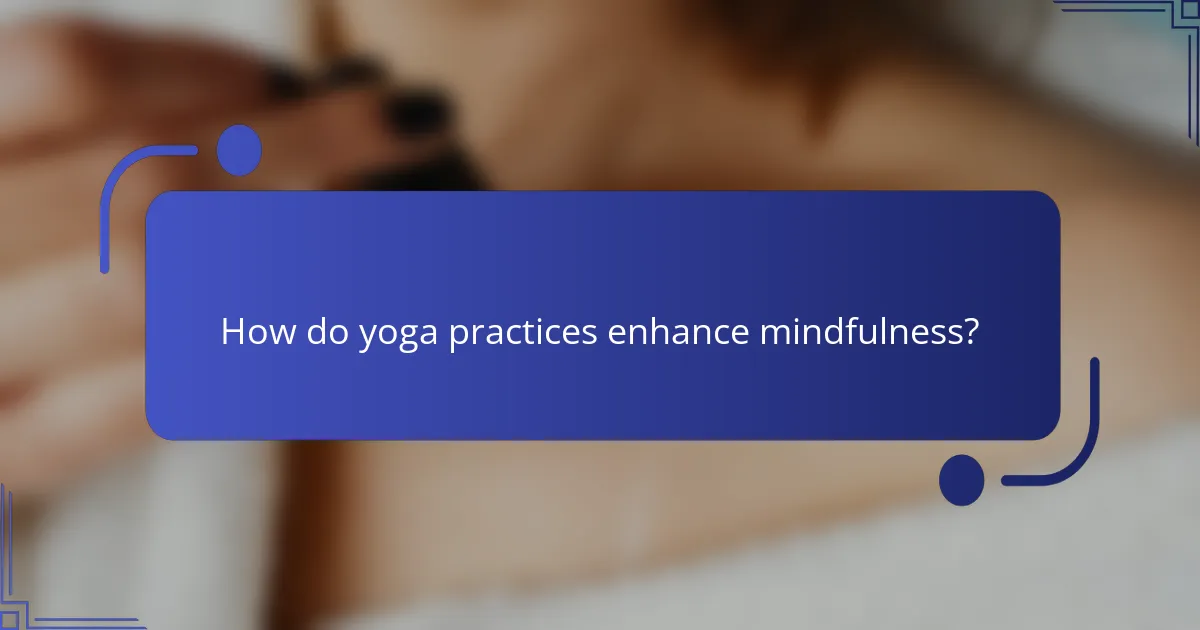
How do yoga practices enhance mindfulness?
Yoga practices significantly enhance mindfulness by promoting present-moment awareness and mental clarity. Techniques such as breath control, meditation, and specific postures cultivate a deeper connection between body and mind.
Engagement in yoga encourages practitioners to focus on their breath and bodily sensations, which reduces distractions. This heightened awareness leads to improved emotional regulation and stress reduction. Research shows that regular yoga practice can increase mindfulness levels by up to 50%, enhancing overall mental strength.
Additionally, unique attributes of certain yoga styles, like Kundalini or Yin yoga, offer distinct benefits. Kundalini emphasizes energy flow and awareness, while Yin focuses on deep stretching and introspection. Both contribute to a comprehensive mindfulness experience.
Incorporating yoga into daily routines fosters resilience and adaptability, essential for navigating life’s challenges. As a result, practitioners often report increased life satisfaction and emotional stability.
What techniques promote present-moment awareness?
Yoga practices enhance present-moment awareness through techniques like breath control, mindful movement, and meditation. These methods cultivate focus and reduce distractions, promoting mental clarity.
1. Breath control: Techniques such as pranayama help regulate breathing, fostering a calm mind.
2. Mindful movement: Asanas encourage awareness of body sensations and alignment, enhancing physical and mental presence.
3. Meditation: Regular practice centers attention, allowing individuals to engage fully with the present moment.
4. Body scanning: This technique involves focusing on different body parts, increasing awareness of physical sensations and tension.
5. Guided imagery: Visualizing peaceful scenes can anchor attention and reduce anxiety, enhancing mindfulness.
Which styles of yoga are most effective for mindfulness?
Hatha, Vinyasa, and Yin yoga are highly effective for mindfulness. These styles promote awareness, breath control, and mental clarity.
Hatha yoga focuses on basic postures and breathing techniques, making it accessible for beginners. Vinyasa yoga emphasizes the flow between poses, enhancing concentration through movement. Yin yoga involves long-held postures, encouraging deep relaxation and introspection.
Practicing these styles consistently can improve mental strength and flexibility while fostering a mindful approach to daily life.
How can breathing exercises improve mindfulness in yoga?
Breathing exercises significantly enhance mindfulness in yoga by promoting focus and relaxation. These techniques help practitioners connect deeply with their breath, fostering awareness of the present moment. As a result, individuals experience improved mental clarity and emotional stability. Regular practice of breathing exercises can lead to a more profound sense of calm and heightened awareness during yoga sessions.
What role does meditation play in yoga for mindfulness?
Meditation enhances yoga by fostering mindfulness, improving focus, and reducing stress. It serves as a foundational practice within yoga, promoting mental clarity and emotional stability. The integration of meditation techniques, such as breath awareness and visualization, deepens the overall experience of yoga. As a result, practitioners often report increased flexibility, both physically and mentally, leading to a more profound connection with their inner selves.

What are the benefits of yoga for flexibility?
Yoga significantly enhances flexibility through various postures and practices. It stretches muscles, improves joint mobility, and promotes better alignment. Regular practice can lead to increased range of motion, reduced risk of injury, and improved overall physical performance. Additionally, yoga fosters mindfulness, which can enhance the body’s awareness during stretching, leading to more effective practice and deeper flexibility gains.
Which poses are best for increasing flexibility?
The best poses for increasing flexibility include Downward Dog, Forward Bend, and Pigeon Pose. These poses target major muscle groups and enhance overall body flexibility. Incorporating these into a regular practice can lead to significant improvements in flexibility and mobility.
How does regular practice affect overall flexibility?
Regular practice significantly enhances overall flexibility. Engaging in yoga consistently stretches muscles and improves joint mobility, leading to greater range of motion. Studies show that participants in regular yoga practices experience a marked increase in flexibility over time. This improvement stems from the combination of dynamic stretching, controlled breathing, and mindful movement inherent in yoga.
What are common challenges faced in achieving flexibility through yoga?
Common challenges in achieving flexibility through yoga include physical limitations, inconsistent practice, mental barriers, and improper techniques. Physical limitations can stem from age or injury, hindering progress. Inconsistent practice affects muscle memory and adaptability. Mental barriers, such as frustration or impatience, can impede motivation. Lastly, improper techniques may lead to ineffective stretching or injury, undermining flexibility goals.
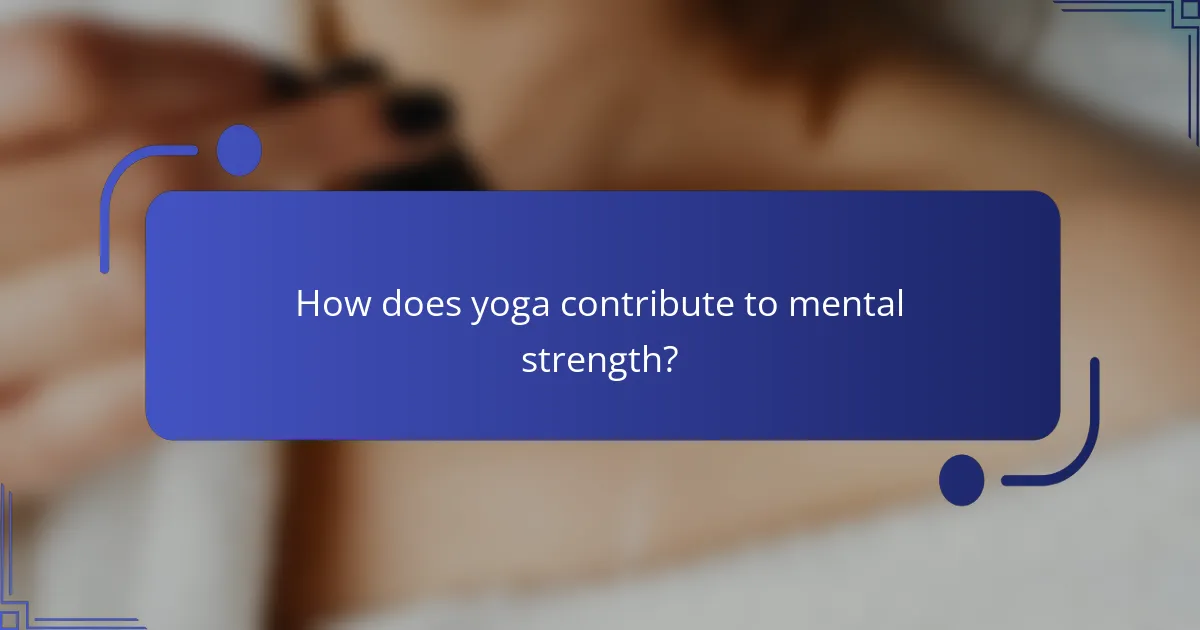
How does yoga contribute to mental strength?
Yoga enhances mental strength by promoting mindfulness, reducing stress, and improving emotional resilience. Through consistent practice, individuals develop greater self-awareness and focus. Techniques such as breath control and meditation foster a calm mind, enabling better coping mechanisms in challenging situations. Research indicates that regular yoga practitioners report higher levels of mental clarity and emotional stability. This holistic approach contributes significantly to overall mental well-being.
What practices build resilience through yoga?
Practices that build resilience through yoga include mindfulness techniques, flexibility exercises, and mental strength training. These practices enhance emotional regulation, promote stress relief, and improve overall well-being.
Mindfulness techniques such as meditation and breath control help practitioners stay present and manage anxiety. Flexibility exercises, including asanas, improve physical resilience and body awareness. Mental strength training through challenging poses fosters perseverance and self-discipline.
Incorporating these elements into a regular yoga routine can significantly enhance resilience, allowing individuals to better cope with life’s challenges.
How can yoga help in stress management?
Yoga effectively reduces stress through mindfulness, flexibility, and mental strength enhancement. Mindfulness practices in yoga promote present-moment awareness, helping individuals manage stress triggers. Regular yoga sessions increase flexibility, which can alleviate physical tension associated with stress. Additionally, yoga builds mental strength, fostering resilience against stressors. Studies indicate that consistent yoga practice lowers cortisol levels, enhancing overall well-being. As a result, integrating yoga into daily routines can significantly improve stress management and emotional health.
Which mental techniques are integrated into yoga for strength?
Yoga integrates several mental techniques to enhance strength, including visualization, breath control, and mindfulness. Visualization helps practitioners mentally rehearse poses and build confidence. Breath control, or pranayama, supports focus and energy management during practice. Mindfulness encourages present-moment awareness, fostering resilience and mental fortitude. These techniques collectively contribute to improved physical and mental strength in yoga.
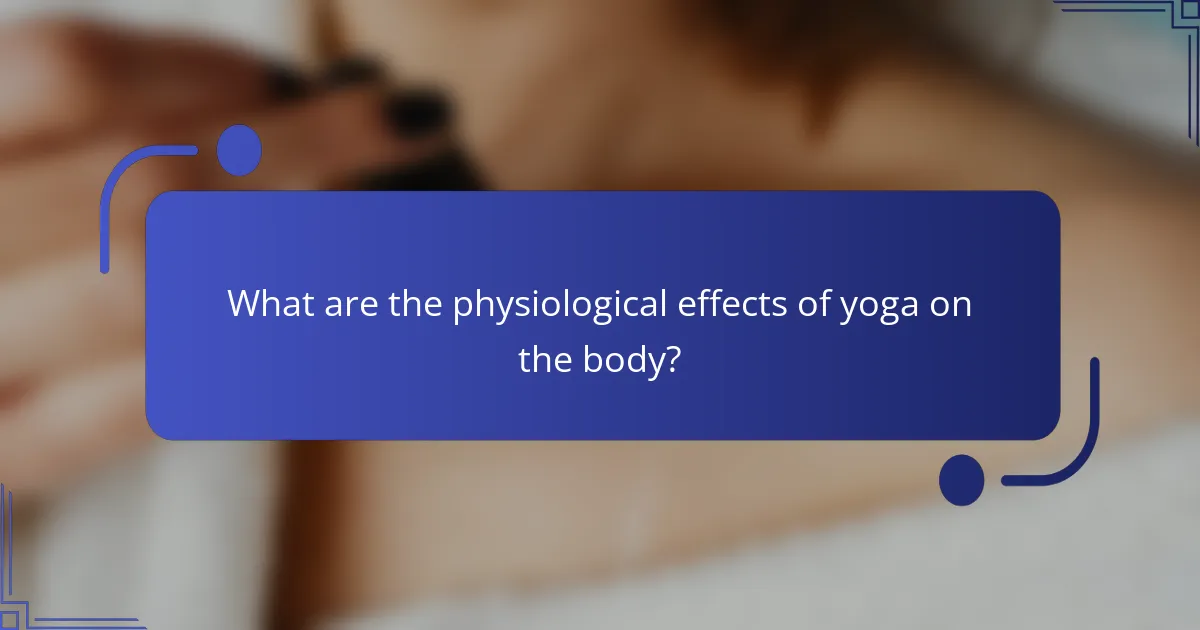
What are the physiological effects of yoga on the body?
Yoga has numerous physiological effects on the body, enhancing overall health and well-being. Regular practice improves flexibility, strengthens muscles, and promotes better posture. It can also lower stress levels, reduce anxiety, and improve mental clarity.
One significant effect is increased blood circulation, which enhances oxygen delivery to tissues. Yoga stimulates the lymphatic system, aiding in detoxification and immune function. Additionally, it contributes to better respiratory efficiency through controlled breathing techniques.
Practicing yoga can lead to lower blood pressure and improved cardiovascular health. Studies show that consistent yoga practice may decrease cortisol levels, promoting relaxation and emotional balance.
Furthermore, yoga enhances proprioception, which is the body’s awareness of its position in space. This can lead to improved coordination and balance, reducing the risk of injuries. Overall, the physiological effects of yoga support both physical and mental health, making it a holistic practice.
How does yoga impact muscle tone and strength?
Yoga significantly enhances muscle tone and strength through a combination of resistance, balance, and flexibility training. Various yoga poses engage multiple muscle groups, promoting endurance and stability. For example, poses like Warrior and Plank build strength by utilizing body weight as resistance.
Additionally, regular practice improves muscle tone by increasing blood flow and oxygen to the muscles, aiding recovery and growth. A 2016 study found that consistent yoga practice can lead to increased muscle strength and endurance, particularly in the core and lower body.
Moreover, yoga fosters mindfulness, which enhances focus and body awareness, contributing to better alignment and technique during practice. This attention to form can prevent injuries and promote more effective strength development.
In summary, yoga’s holistic approach not only builds muscle tone and strength but also supports overall physical and mental well-being.
What are the long-term health benefits associated with yoga?
Long-term health benefits of yoga include improved flexibility, enhanced mental strength, and increased mindfulness. Regular practice can lead to reduced stress, better emotional regulation, and lower risk of chronic diseases. Studies show that yoga contributes to better cardiovascular health, with participants experiencing a 30% reduction in heart disease risk. Additionally, yoga promotes better sleep quality and cognitive function, fostering overall well-being. As a unique attribute, yoga’s holistic approach integrates physical, mental, and spiritual wellness, making it distinct from other fitness regimens.
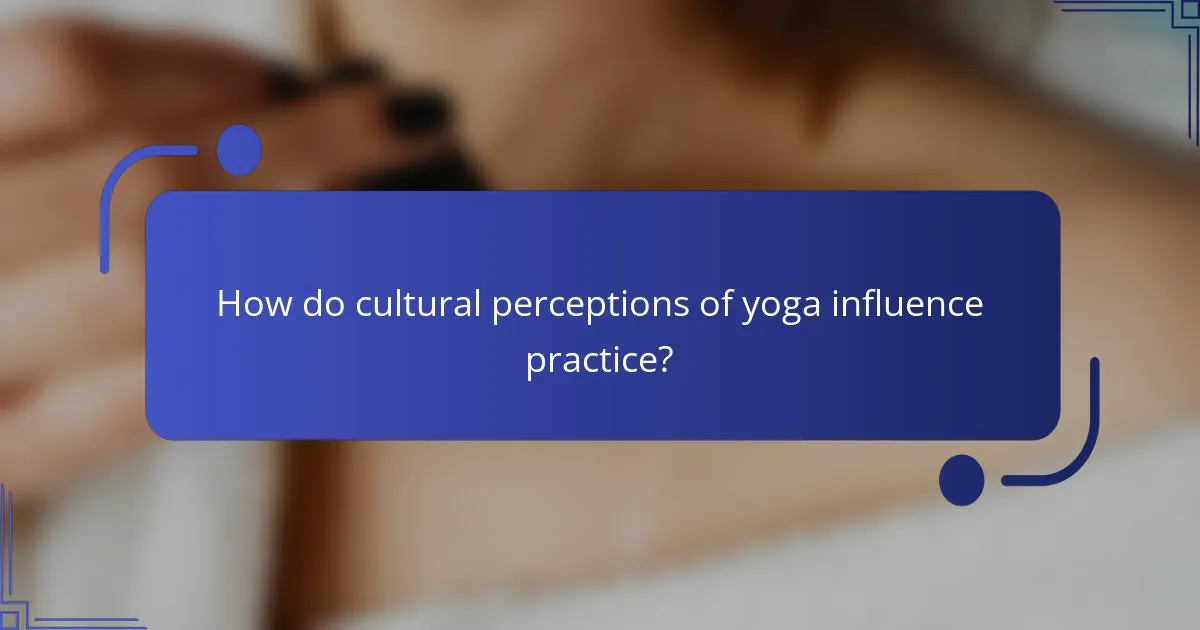
How do cultural perceptions of yoga influence practice?
Cultural perceptions of yoga significantly shape its practice. Different cultures emphasize various aspects of yoga, influencing how practitioners approach mindfulness, flexibility, and mental strength.
In Western contexts, yoga often focuses on physical fitness and stress relief. This perspective prioritizes flexibility and physical postures, appealing to those seeking health benefits. In contrast, Eastern traditions emphasize spiritual growth and meditation, fostering a deeper connection to mental strength.
Cultural backgrounds also affect the interpretation of yoga’s purpose. For instance, in India, yoga is viewed as a holistic lifestyle, integrating ethics and philosophy. This unique attribute enriches the practice with a sense of purpose beyond physical exercise.
As a result, understanding these cultural influences can enhance one’s yoga experience, allowing practitioners to appreciate diverse practices and their underlying philosophies.
What variations of yoga are popular in different regions?
Hatha, Vinyasa, Ashtanga, Iyengar, and Kundalini are popular yoga variations across different regions. Hatha is prevalent in the West for its foundational postures. Vinyasa, known for its dynamic flow, is favored in urban centers. Ashtanga, with its structured sequences, attracts dedicated practitioners. Iyengar emphasizes alignment and props, appealing to those seeking precision. Kundalini focuses on spiritual awakening, popular in holistic communities. Each style offers unique benefits, contributing to the global yoga landscape.
How do local traditions shape yoga practices?
Local traditions significantly influence yoga practices by integrating cultural beliefs and values. These practices vary widely based on geographic and historical contexts, shaping how mindfulness, flexibility, and mental strength are approached. For example, in India, yoga often emphasizes spiritual growth, while in the West, it may focus more on physical fitness. Regional variations introduce unique postures and rituals, enhancing the overall experience. Additionally, local festivals and community gatherings can create a sense of belonging, further enriching the practice. This blend of tradition and modernity fosters a diverse and evolving landscape in yoga practices.
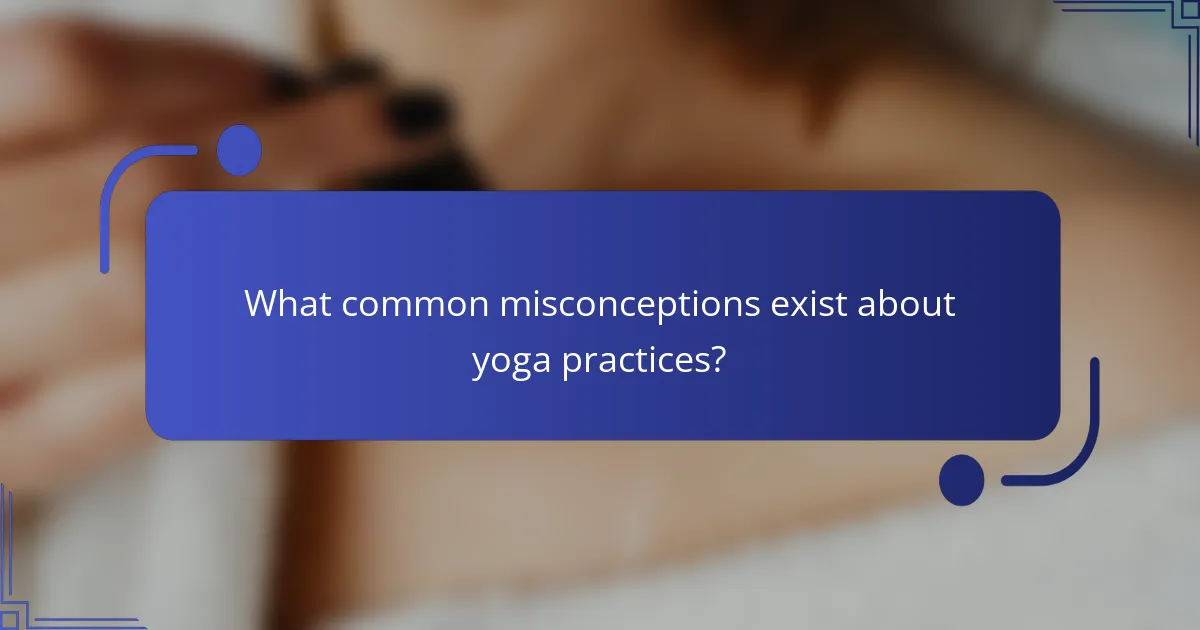
What common misconceptions exist about yoga practices?
Many misconceptions about yoga practices exist. One common myth is that yoga is solely for flexibility. While it enhances flexibility, it also improves strength and mental focus. Another misconception is that yoga is only for women. Men can benefit significantly from yoga’s physical and mental aspects. Some believe yoga requires prior experience or advanced skills, but beginners can easily start with foundational poses. Additionally, many think yoga is a religious practice, but it primarily emphasizes physical and mental well-being. Finally, some assume yoga is a workout without recognizing its meditative qualities that promote mindfulness.
How can misinformation affect the practice of yoga?
Misinformation can significantly undermine the practice of yoga by promoting incorrect techniques and unsafe practices. This can lead to physical injuries or mental distress, detracting from yoga’s benefits for mindfulness, flexibility, and mental strength.
For example, false claims about the necessity of extreme postures can discourage beginners and foster a negative experience. Misleading information about the spiritual aspects of yoga can also create confusion, impacting practitioners’ focus and commitment.
As a result, ensuring access to accurate and credible resources is crucial for maintaining the integrity of yoga practices. This helps practitioners achieve their health and wellness goals safely and effectively.
What are the most prevalent myths surrounding yoga?
Many myths surround yoga, often misrepresenting its practices and benefits. Common misconceptions include the belief that yoga is solely for flexibility, that it requires advanced physical ability, and that it is a purely physical exercise. Additionally, some think yoga is only for women or that it is incompatible with other fitness routines. These myths can deter individuals from experiencing yoga’s mental strength and mindfulness benefits.
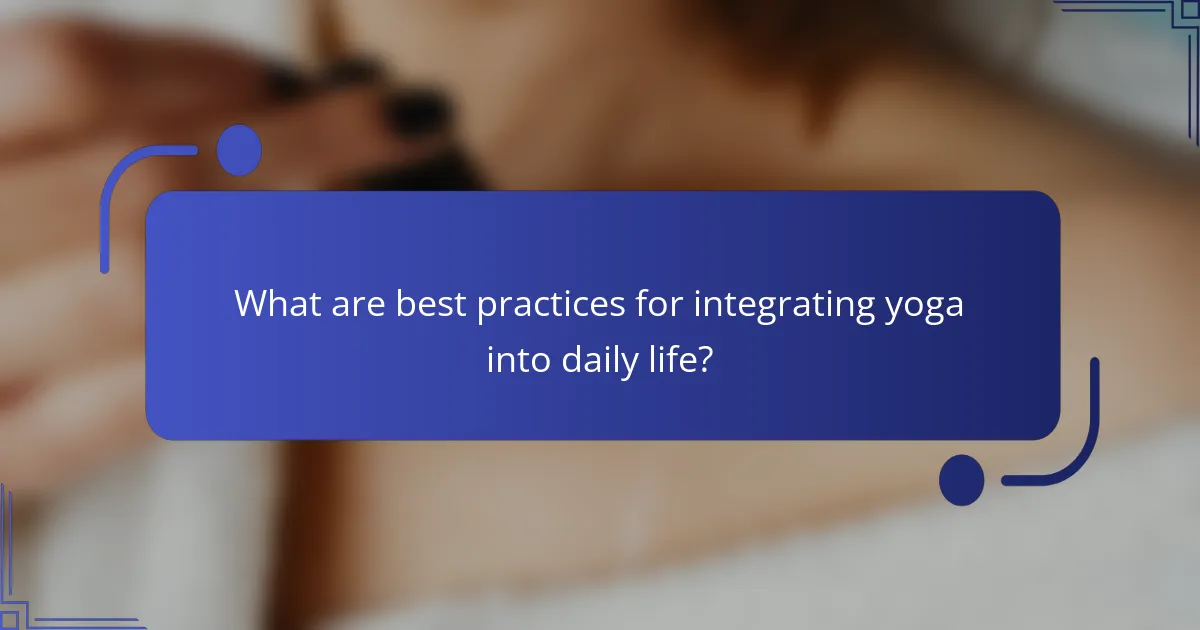
What are best practices for integrating yoga into daily life?
Integrating yoga into daily life enhances mindfulness, flexibility, and mental strength. Start with a consistent schedule, dedicating 15-30 minutes daily for practice. Incorporate various styles, such as Hatha for flexibility and Vinyasa for mindfulness. Use reminders or apps to maintain motivation and track progress. Engage in mindful breathing techniques throughout the day to reinforce mental clarity. Join community classes or online sessions for social support and accountability. Consider integrating yoga poses into breaks at work to alleviate stress and improve focus.
How can one create a sustainable yoga routine?
To create a sustainable yoga routine, establish consistency, set realistic goals, and listen to your body. Start by dedicating specific days and times each week for practice. Incorporate a variety of styles, such as Hatha for flexibility and Vinyasa for strength. As a result, this diversity enhances overall well-being and keeps the routine engaging. Prioritize mindfulness by focusing on breath and body awareness during sessions, which fosters mental clarity and reduces stress. Regularly assess your progress and adjust your routine to maintain motivation and prevent burnout.
What tips do experts recommend for beginners?
Experts recommend starting with foundational poses, focusing on breath control, and practicing regularly. Beginners should prioritize mindfulness to enhance mental strength and flexibility. Incorporating short sessions daily can build consistency and confidence. Joining a class or using guided videos can provide additional support and structure.
How can one avoid common pitfalls in yoga practice?
To avoid common pitfalls in yoga practice, focus on proper alignment, listen to your body, and maintain a consistent routine. Practicing mindfulness enhances awareness of your limits, preventing injuries. Incorporating breathing techniques can also improve focus and mental strength. Regularly reassess your goals to ensure they align with your practice.


